Please Care for Maui’s Reefs While You Enjoy Our Nearshore Ocean Waters
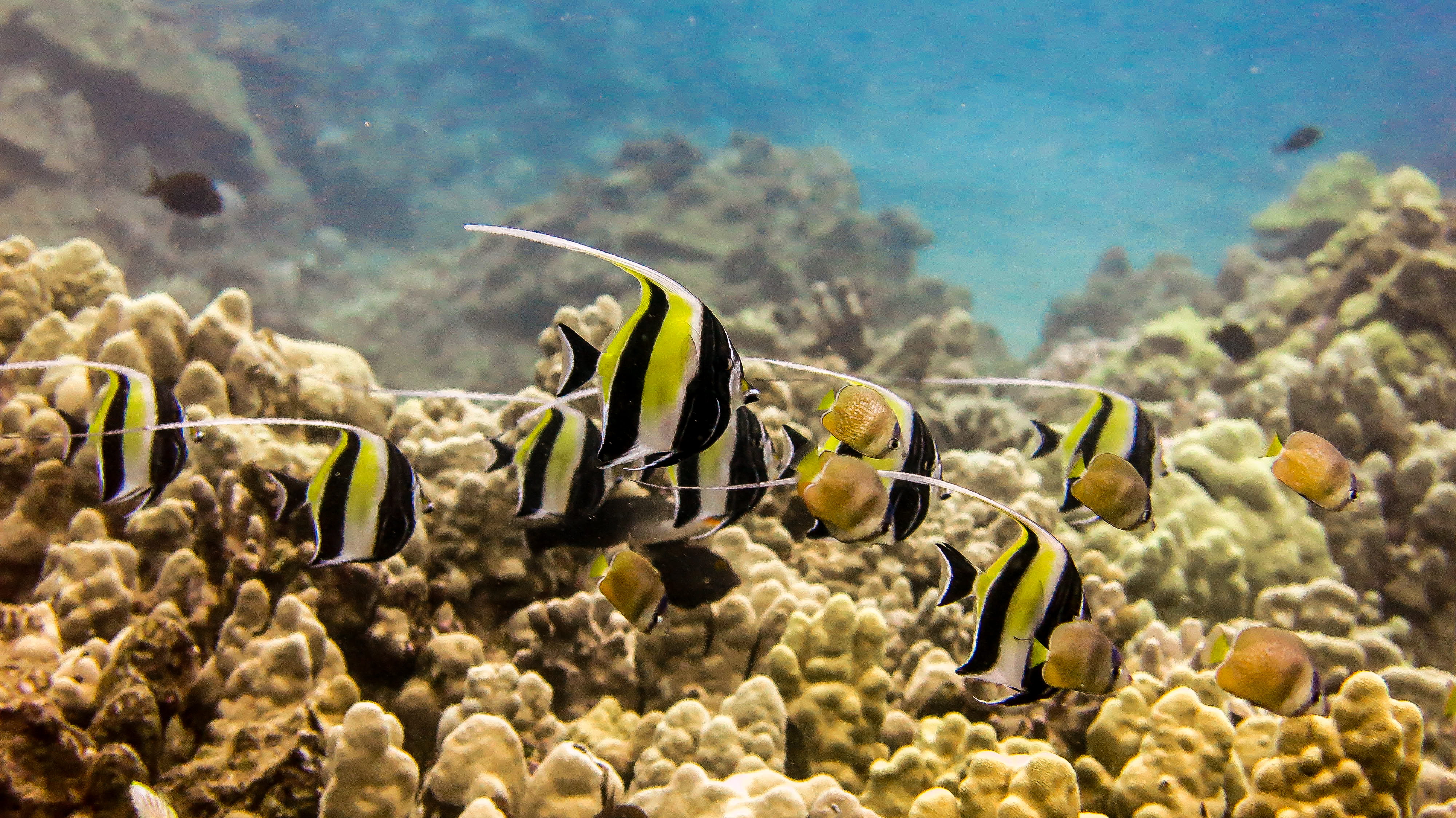 Coral reefs may look like rock but they are actually made of tiny, fragile, living animals called coral polyps that can be harmed or killed when you stand or walk on them. A wayward kick of your swim fins or a surfboard or paddleboard scraping against the reef’s surface can also damage corals.
Coral reefs may look like rock but they are actually made of tiny, fragile, living animals called coral polyps that can be harmed or killed when you stand or walk on them. A wayward kick of your swim fins or a surfboard or paddleboard scraping against the reef’s surface can also damage corals.
When you enter the ocean, please do so with care and respect for our marine ecosystems. Please follow these simple guidelines to help protect Maui’s coral reefs.
- Avoid standing, walking upon, or kicking coral.
- If you must stand, do so only on sand.
- Keep your fins up while snorkeling — a flotation device helps.
- Never touch corals. They are sharp and can cut you. Viruses, bacteria, and stinging cells living within the corals can also cause serious infections. If you are cut by coral, leave the water immediately and care for your wound. Click here to learn how to treat coral cuts.
- Secure your gear; don’t let your camera or fishing equipment drag across the reef.
- Watch where you paddle; avoid shallow water over reefs to avoid accidentally scraping and harming corals.
- Carrying a surfboard? Walk into the water over sand or gravel to avoid damaging corals.
Does Your Sunscreen Harm Corals?
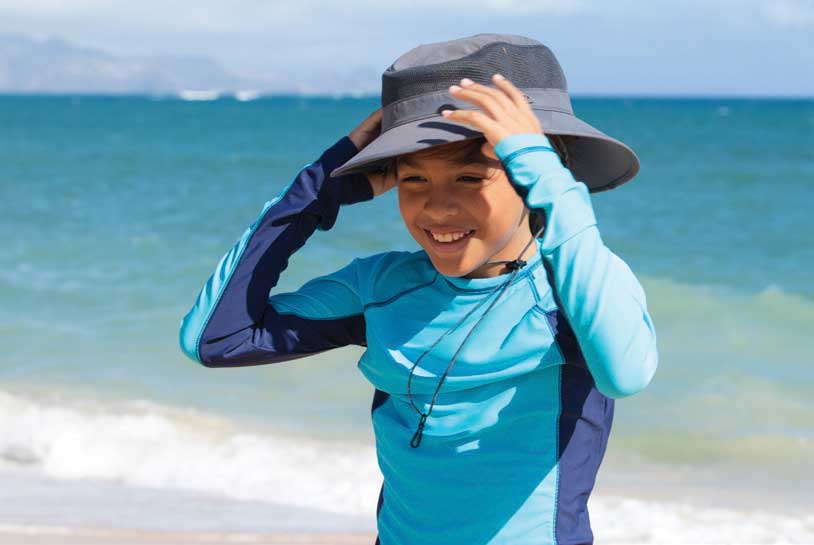
Researchers have found that common sunscreen chemicals can harm or kill corals, even in small concentrations.
Hawaiʻi passed the nation’s first law banning the sale of sunscreen products containing oxybenzone and octinoxate, two common sunscreen ingredients that “have significant harmful impacts on Hawaii’s marine environment and residing ecosystems.” That law went into effect in January of 2021.
The County of Maui banned the sale, distribution and/or use of non-mineral sunscreen as of October 1, 2022. This means only mineral-based sunscreens are now allowed for sale or use in Maui County.
But why wait to switch to sunscreens that are safer for our coral reefs and marine life? Let us help you get started.
- Avoid sunscreen and body care products containing oxybenzone and octinoxate, as well as avobenzone and octocrylene.
- Choose non-nano zinc or titanium-dioxide based products instead.
- Skip spray-on products that leave residues on the sand that can get washed into the ocean.
- Reduce your need for sunscreen by covering up with a rash guard, hat, umbrella, or swim tights.
- Get more info about reef-safe sunscreen choices. Click here.
It’s easy to make the switch to safer-for-the-reef alternatives. Check out our short video.
 A World of Wonder
A World of Wonder
As you snorkel or dive here, you encounter rare and unique marine life. Because Hawaiʻi is surrounded by thousands of miles of ocean, the species that found their way here evolved in isolation. As a result, about 25% of our corals, fish, and marine algae are endemic, which means they are found nowhere else on Earth.
Coral reefs are formed by compact colonies of tiny soft-bodied animals known as coral polyps. Coral polyps have tiny tentacle-like arms that extend to sweep food into their mouths. Each polyp makes a hard outer skeleton of limestone (calcium carbonate) that either attaches to rock or to the dead skeletons of other coral polyps. Over time, these limestone skeletons build up and create the hard structure of the reef. Some of Hawaiiʻs local coral reefs are hundreds of years old.
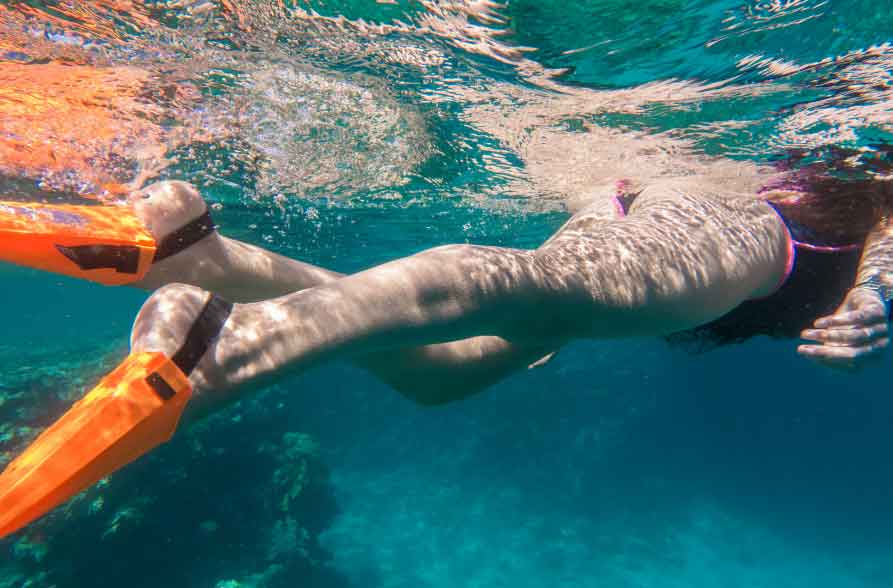 Take Care Around Corals
Take Care Around Corals
Please remember that coral polyps are delicate. Each polyp is no thicker than a nickel, and they can be crushed and killed when you stand or walk upon them. Once a polyp dies, it can no longer build the reef. If the entire colony perishes, the reef structure breaks down and disappears.
Coral reefs are valuable for many reasons: in addition to their beauty and diversity of life, they support about 25 percent of Hawaiiʻs marine life. Corals also protect our shorelines and beaches from storm surges, big waves, erosion, and storms. Unfortunately, coral reefs are among the most threatened ecosystems on the planet due to climate change, warming oceans, ocean acidification, and pollution. Help our reefs survive by taking care when you snorkel, swim, dive, paddle, or surf near coral.
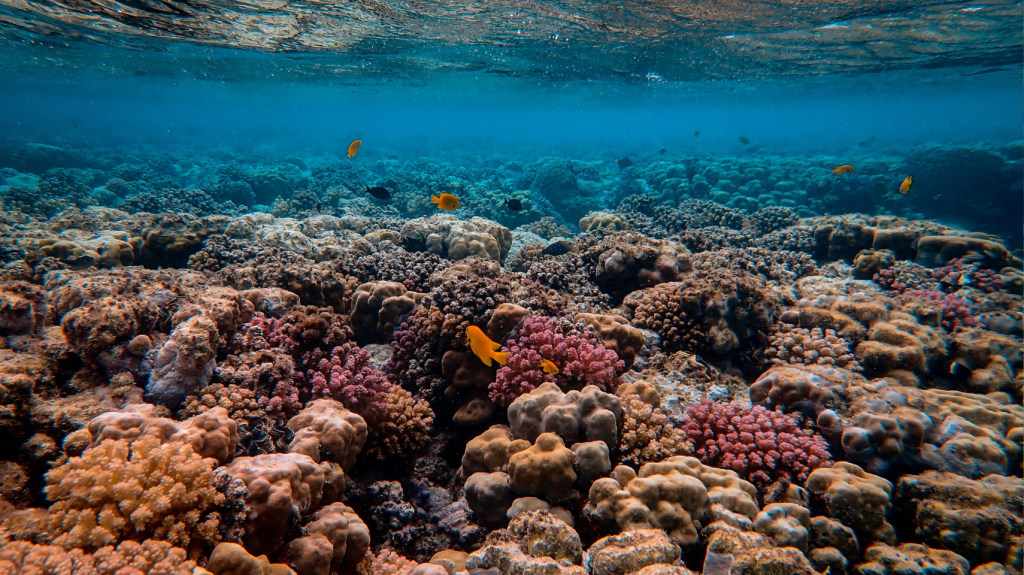 Coral Bleaching Threatens Our Reefs
Coral Bleaching Threatens Our Reefs
Most corals obtain energy from beneficial algae called zooxanthellae (pronounced zo-UH-zan-thuh-lay) that live within their bodies. The algae produce energy from sunlight; this energy helps nourish the corals. The algae also give corals their color.
Corals can become stressed by warming ocean water, too much freshwater, sedimentation or pollution. When this stress occurs, the beneficial algae leave the coral tissues. This causes the corals to turn white, which is known as coral bleaching. Corals can survive without the algae (and the energy it produces) temporarily, but eventually, the corals die.
Ocean warming caused by climate change has caused significant coral bleaching and coral deaths in Hawaiʻi.
How you can help:
- Speak out and help fight climate change.
- Reduce your use of household and landscape chemicals.
- Support programs that protect ocean water quality and prevent sediment runoff into the sea.
Learn More About Hawai’i’s Coral Reefs
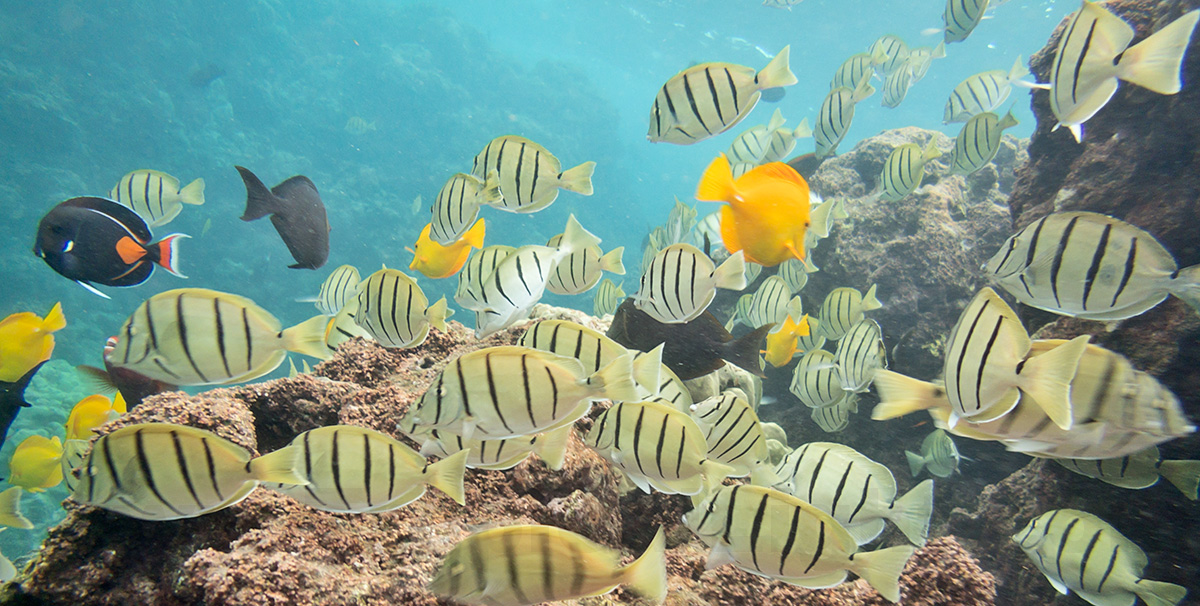
What Corals Will You See?
The most common corals found in Hawaii’s nearshore reefs are Porites (smooth coral), Montipora (rice coral) and Pocillopora (small branching coral). Visit Eyes on the Reef – Hawaii to learn to identify our local coral reef species.
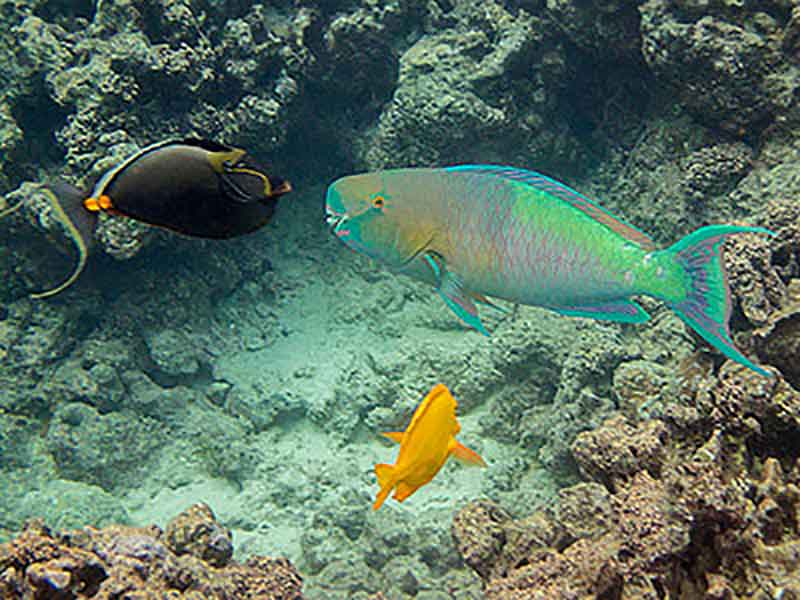
Some of Hawaii’s reef fishes: Orangespine Unicornfish, Parrotfish and Yellow Tang
Hawaii’s Reef Fish
 Get to known Hawaii’s famous state fish (Humuhumunukunukuapua’a) and other fascinating inhabitants of our reef.
Get to known Hawaii’s famous state fish (Humuhumunukunukuapua’a) and other fascinating inhabitants of our reef.
- View our fish ID video
- Download a FREE Hawaii fish ID card
(A printed waterproof version of this card is available for purchase here) - Learn to ID other nearshore fish of Hawaii

Hawaii’s Sea Turtles
The most commonly sighted sea turtle in Hawaiʻi is the green turtle, a species listed as threatened under federal and state law. Youʻll find green turtles swimming among our nearshore coral reefs or basking on shore at some of our island beaches. Hawksbill turtles are also found here, but sightings are infrequent. Hawksbill turtles are listed as endangered. It is illegal to harm, harass or kill these marine reptiles.
- Always give turtles at least 10 feet or more of space. - Never touch or attempt to feed sea turtles.
- Call (888) 256-9840 to report stranded, injured or entangled sea turtles.
- Download a free sea turtle reference card
(A printed waterproof version of this card is available for purchase here) - Learn more about Hawaii’s sea turtles.
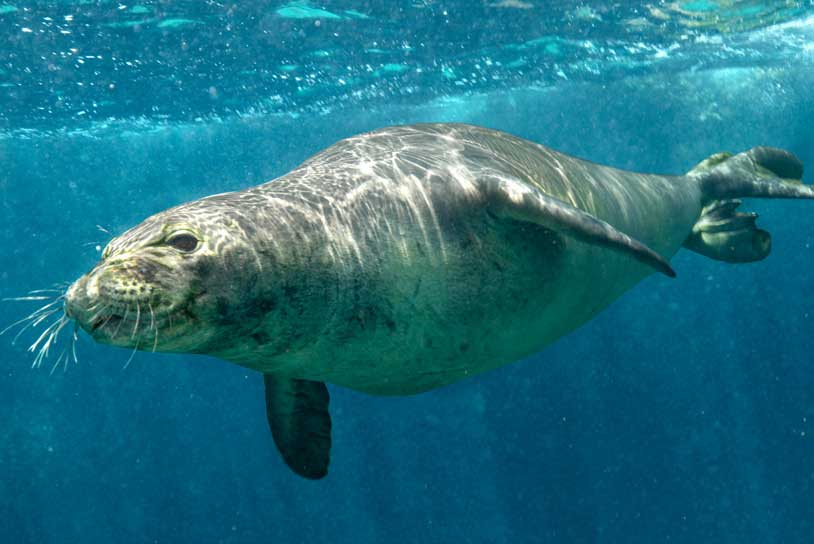
Hawaiian Monk Seals
Itʻs a special treat to see a Hawaiian monk seal. There are critically endangered, with only about 1,200 of these seals alive today.
- If you see a monk seal in the water, exit the water immediately for your safety.
- Hawaiian monk seals also haul out on our beaches to rest, give birth and care for their pups. Keep your distance and also keep your pets away. Stay behind any signs or barriers.
- Use the “rule of thumb” to determine a safe distance (if no signs or barriers are present)
◦ Make a “thumbs up” gesture and extend your arm straight in from of you.
◦ Turn your thumb parallel to the ground in your line of sight of the seal.
◦ If your thumb covers the entire seal, you are far enough away (about 50 feet or 15 meters). - Learn more about viewing monk seals, dolphins and whales of Hawaiʻi.
- Call (888) 256-9840 to report stranded, injured or entangled monk seals, dolphins and whales.
Learn About Maui Nui Marine Resource Council’s Work to Protect Maui’s Coral Reefs
Maui Nui Marine Resource Council is a nonprofit Maui-based organization working for healthy coral reefs, clean ocean water and abundant native fish. Some of our current projects include:
- Visitor education programs, including displays at Kahului Airport, coral reef information signs at 39 Maui beach locations, radio and print public service announcements and more.
- Our Hui O Ka Wai Ola ocean water quality monitoring program, co-founded and co-managed with The Nature Conservancy and West Maui Ridge to Reefs Initiative.
- Using caged oysters to remove sediments and pollutants from ocean water in Ma’alaea Bay
- Working in Pohakea Watershed to prevent stormwater runoff from transporting sediment into Ma’alaea Bay.
- Our Reef-Friendly Landscaping Program to keep reef-damaging pesticides and landscaping chemicals out of our ocean waters.We welcome your support of our work.
Be Safe!
Get important tips on ocean safety at HIOceanSafety.com



